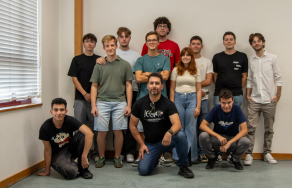O docente e investigador Hugo Terças (DF/ISEL) publicou, recentemente, um artigo de acesso livre na Physical Review Letters (PRL), intitulado “Unveilling the Hidden Pathway: How Axion-Plasmon Conversion Reshapes Our Search for dark Matter”.
No artigo, o docente do ISEL, em colaboração com Tito Mendonça (GoLP/IPFN) e Robert Bingham (Rutherford Appleton Laboratory), revela um novo mecanismo na conversão de axiões em estrelas de neutrões que pode alterar significativamente a forma como procuramos matéria escura. Os investigadores descobriram que, antes de se converterem em sinais de rádio detetáveis, muitos axiões transformam-se silenciosamente em ondas de plasma (plásmons) dentro da magnetosfera destas estrelas, reduzindo os sinais esperados.
Esta descoberta desafia as abordagens atuais e exige uma reavaliação das estratégias de deteção, reforçando o papel da investigação teórica no avanço da Astrofísica e posicionando o ISEL na vanguarda da Física fundamental.
É de referir que a PRL trata-se de uma revista científica de elevado prestígio, sujeita a revisão por pares, que publica investigação de grande impacto em Física e áreas relacionadas. Reconhecida pela sua exigência editorial e rapidez no processo de publicação, a PRL é uma das principais plataformas para a divulgação de descobertas inovadoras, contribuindo significativamente para o avanço do conhecimento científico e tecnológico a nível global.
Leia, abaixo, o texto descritivo do artigo:
Dark matter constitutes approximately 85% of the matter in our universe, yet its fundamental nature remains one of the most profound mysteries in modern physics. Among the leading candidates are axions—hypothetical particles originally proposed to solve a fundamental symmetry problem in quantum chromodynamics. These elusive particles could simultaneously explain dark matter and resolve a decades-old puzzle in particle physics.
Neutron stars, particularly magnetars with their immensely powerful magnetic fields, have emerged as natural laboratories for axion detection. As dark matter axions stream through these extreme environments, they should convert into detectable radio waves through a process known as axion-photon conversion. This mechanism has formed the basis for numerous observational campaigns using the world's most sensitive radio telescopes.
In groundbreaking research recently published in Physical Review Letters, Hugo Terças from ISEL's Department of Physics (Instituto Superior de Engenharia de Lisboa), in collaboration with Tito Mendonça from GoLP/IPFN and Robert Bingham from the Rutherford Appleton Laboratory, has revealed a previously overlooked phenomenon that substantially alters this picture. The research team discovered that before axions can convert into detectable radio waves, a significant portion instead convert into plasma waves (plasmons) deep within the neutron star's magnetosphere. This "silent" conversion pathway acts as an energy drain, diminishing the expected radio signals that astronomers search for.
This discovery, emerging from ISEL's growing research excellence in fundamental physics, forces a major reassessment of dark matter detection strategies. The anticipated radio signals from axion conversion may be substantially fainter than previously predicted, meaning current experimental constraints may be too optimistic, and future searches must account for this damping effect. This interdisciplinary work connects fundamental particle and plasma physics with astrophysical observations, demonstrating how theoretical insights from engineering physics can reshape our understanding of the cosmos.
The journey to detect dark matter requires not just powerful telescopes but also deep theoretical insights into how these elusive particles manifest in observable signals. This discovery of axion-plasmon conversion represents exactly this type of insight—one that moves us from looking for what we expect to see to understanding what we might actually find, while positioning ISEL at the forefront of cutting-edge astrophysical research.







